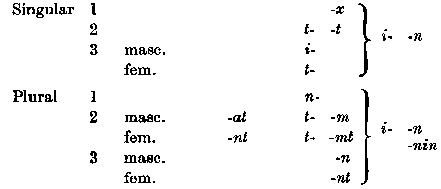Published online by Cambridge University Press: 24 December 2009
The following chant, one of a series recorded in central Morocco in the summer of 1967, exemplifies a type of oral tradition found among the Imazighen, the Berbers of that region. It is a socio-religious poem, called a tanšhat: (plural tinšhadri). The poet-performer is an anšhad (pl. inšhadn), although like other musical performers he is addressed as ‘Shaykh’. The genre, known by other names in other regions, is characterized by its form and language, its composition and execution, its subject-matter and the poet's attitude toward it, and finally by its role in the life of the community.
1 Field-work was supported by the Graduate School of the University of Wisconsin, Madison. Subsequent work on the texts, in the summer of 1968, has been supported by the American Council of Learned Societies.
2 A characterization of which is beyond the scope of this paper. It appears similar to that of Berber poetry in Algeria as noted in Memmi, A., La poésie algérienne, Paris, 1963Google Scholar.
3 See, for example, Hiskett, M., ‘The “Song of Bagauda”: a Hausa king list and homily in verse’, BSOAS, xxvn, 3, 1964–XXVIII, 2, 1965Google Scholar, esp. part I, BSOAS, xxvii, 3, 1964, 540–67.
4 Harries, Lyndon (ed. and tr.), Swahili poetry, Oxford, 1962Google Scholar.
5 Since the sale of the grain harvest in July or August marks the economic high point of the year for most Berber families, such family rites as betrothals, weddings, and circumcisions tend to take place then. In 1967, a poor harvest after a drought combined with the depressing effect of the Israeli-Arab war to produce austerity and a scarcity of festivals. My harvest of texts was correspondingly slim.
6 Penchoen, Thomas G. (Étude syntaxique du parler berbère (Ckaouīa) des Ait-Frah, unpublished Ph.D. thesis presented to the Faculté des Lettres et Sciences Humaines de l'Université de Paris, 196?)Google Scholar calls these units ‘tendu’ and represents them by double letters; Bynon, J. (‘Riddle telling among the Berbers of central Morocco’, African Language Studies VII, 1966, 80–104)Google Scholar also uses double letters, for what he calls ‘geminates’. I concur with the usage of Applegate, J. R. (An outline of the structure of Shilha, New York, 1958)Google Scholar, and with the research group on Arabic and Berber oral tradition (RCP 43) at the Centre National de la Recherche Scientifique, at Paris, in treating these ‘geminates’ as single units, even though they often result from assimilation and reduction in combinations of morphemes. This avoids the problem of how to distinguish between the geminates, which are phonetically fortis or tense (i.e. longer and/or stronger in articulation), and a sequence of two like consonants which may be divided by a short, non-phonemic vowel. A representation such as /mmmi/ ‘my son’ is ambiguous; /mm:i/ is not.
7 ‘Verb’ designates a verb stem and its subject affix, which is zero for imperative singular. The three paradigms of subject affixes in this dialect are shown below for reference in identifying verb stems, and shifts in agreement.
Number, person, gender Imperative Indicative Relative
